
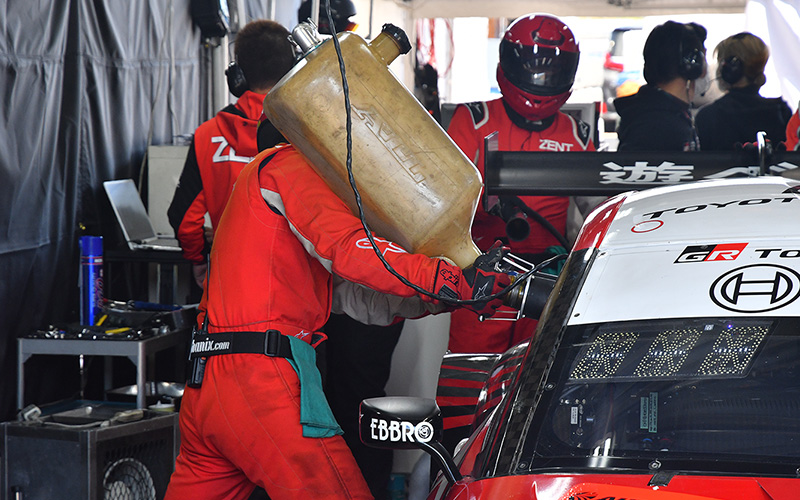
On November 7th (Mon), the day after the 8th and final round of the 2022 SUPER GT series, at the same Mobility Resort Motegi track, tests were conducted using the Carbon Neutral Fuel (CNF) planned for use in 2023 series.
GTA has announced its “SUPER GT Green Project 2030” aimed to serve as an environmental road map for cutting total CO2 emissions resulting from the entire SUPER GT series in half by the year 2030 as part of efforts to make the entire series Carbon Neutral. From 2023, plans call for all participating cars to use the CNF (derived from non-fossil fuel-based biomass), and in these tests the “GTA R100” CNF produced by Germany’s Haltermann Carless was used by all the participating cars, and comparisons were also made with the regularly used gasoline fuels.
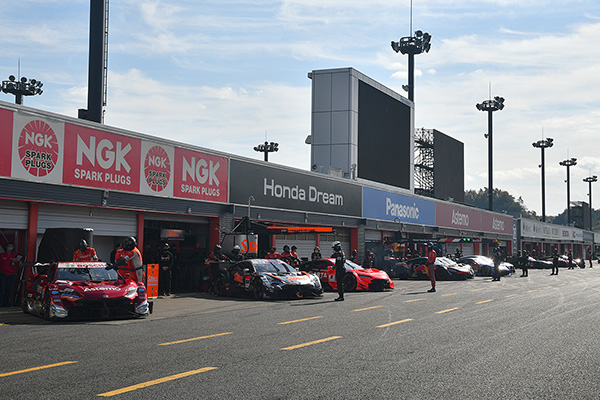
■CNF Test Conditions
This test day was blessed with clear skies from morning and participating in this day’s tests were 13 GT500 class cars (the No. 12 CALSONICIMPUL Z and the No. 24 REALIZE corporation ADVAN Z did not participate). Also, of the 10 GT300 class cars scheduled to participate in the tests, the No. 30 apr GR86 GT that had suffered machine damage in the Round 8 Race the previous day was able to complete repairs in time to participate from the later stages of the morning test session, but the repairs could not be completed on the No. 25 HOPPY Schatz GR Supra to enable it to participate. So in all, nine GT300 class cars participated.
In the morning test session, the No. 23 MOTUL AUTECH Z recorded the fastest time among the GT500 class cars with a lap of 1’37.285. The second fastest time of 1’37.348 was recorded by the No. 100 STANLEY NSX-GT and the third fastest by the No. 3 CRAFTSPORTS MOTUL Z. The fourth and fifth fastest times were recorded by the No. 17 Astemo NSX-GT and the No. 16 Red Bull MOTUL MUGEN NSX-GT, while the sixth fastest time was recorded by the No. 14 ENEOS X PRIME GR Supra.
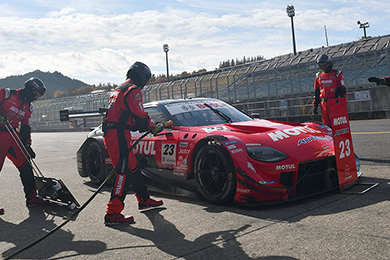
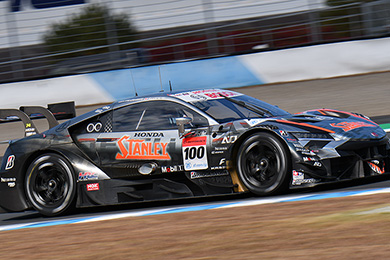
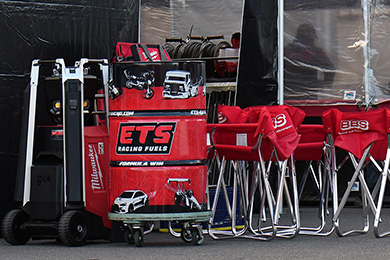
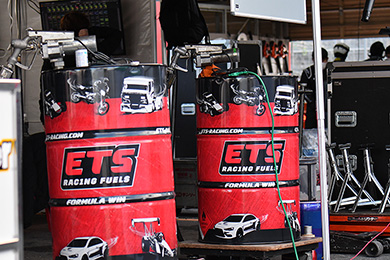
The fastest time in the GT300 class was the 1’46.827 lap recorded by the No. 11 GAINER TANAX GT-R (driven by the No. 10 car driver Tomita), but this was run on normal gasoline fuel. The second fastest time was a 1’47.045 lap recorded by the No. 65 LEON PYRAMID AMG, while the third fastest time was recorded by the No. 61 SUBARU BRZ R&D SPORT.
After the morning test session, the former SUPER GT driver and current national parliament member, Sakon Yamamoto, visited the pits of the different carmakers along with representatives of the Liberal Democratic Party Parliamentary Association for Motorsports to exchange opinions on the subject of SUPER GT’s efforts to shift to carbon-neutral fuels and the conditions of CNF fuel use.
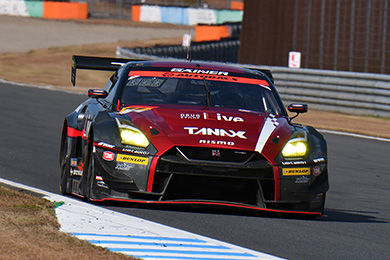
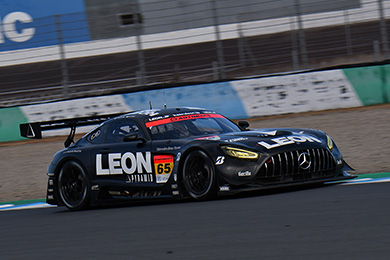
In the afternoon test session, there were once again 13 GT500 cars participating, while in the GT300 class there were seven participating cars, due to the withdrawal car No. 11 and the No. 65 LEON PYRAMID AMG. All the teams continued testing until 4:00 in the afternoon using the prescribed CNF fuel as well as making test runs using their usual gasoline fuel.
In this session the fastest time was a 1’37.453 lap recorded by the No. 3 CRAFTSPORTS MOTUL Z. The second and third fastest times were a 1’37.710 by the No. 17 Astemo NSX-GT and a 1’37.943 by the No. 16 Red Bull MOTUL MUGEN NSX-GT. The fourth and fifth fastest times went to the No. 23 MOTUL AUTECH Z and the No. 39 DENSO KOBELCO SARD GR Supra.
The fastest time in the GT300 class was a 1’46.766 by the No. 7 Studie BMW M4. The second and third fastest times were a 1’47.393 by the No. 20 SHADE RACING GR86 GT and a 1’47.682 by the No. 2 muta Racing GR86 GT.
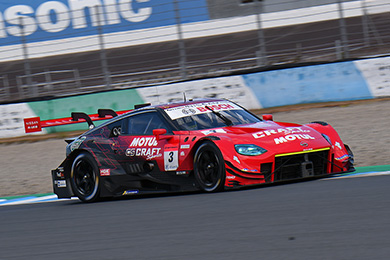
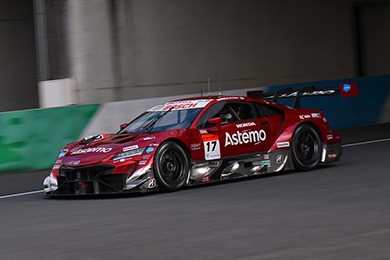
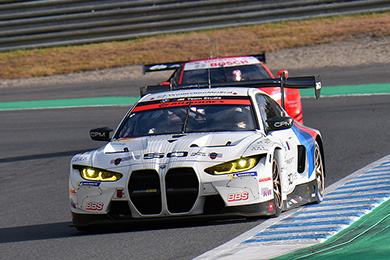
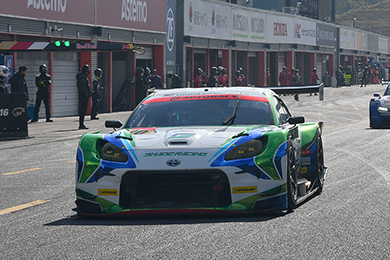
■CNF Test Participating Driver Comments
Ronnie Quintarelli (No. 23 MOTUL AUTECH Z)
“To tell the truth, I had no uncomfortable feelings using the carbon-neutral fuel. The GT500 car has what you could call an “aggressively designed engine” with a lot of advanced technologies applied in it. So, I thought that changing the fuel used would result in some (significant) changes, but in fact the changes were so small that I wouldn’t have noticed them if I hadn’t been told about the fuel change. Of course, there were careful adaptations made to the mapping (fuel injection programming), but I didn’t have any uncomfortable feelings about the acceleration response we drivers want. I thought that was rather incredible. NISMO has already done some bench testing, and we had used carbon-neutral fuel in this year’s SUPER TAIKYU competition, so I believe we were able to put to use data gained from those experiences.”
Ukyo Sasahara (No. 16 Red Bull MOTUL MUGEN NSX-GT)
“I believe that at this stage the adjustments are not perfect, and I feel that the power output is a little less than with our normal gasoline fuel. However, the feeling was more natural than I had expected. Of course, there are still a lot of measures to be taken. Also, I was a bit conscious of the smell. It may be because this is the first time, but I was conscious of the smell from the other machines’ exhaust in the pit area.”
Hiroaki Ishiura (No. 38 ZENT CERUMO GR Supra)
“I started out carefully, but I didn’t feel anything particularly unusual or bothering. I held back on the power at first, but the only thing I felt was that the up-shift point was a bit deeper than it had been in yesterday’s race, but after that I felt that I could drive without anything bothering me. I almost couldn’t feel that I was doing a carbon-neutral fuel test (laughs). Since they had made some adjustments based on the bench tests, there was no problem in terms of drivability.”
Hiroki Yoshida (No. 52 SAITAMATOYOPET GB GR Supra GT)
“At the beginning, we started running with the engine performance restricted and then we gradually raised it a bit at a time. And in the end, there was no uncomfortable feeling at all using the carbon-neutral fuel as I drove. There were also no problematic effects on the other parts of the machine. As I ran, however, I did feel something different about the smell of the other cars’ exhaust.”
Takuto Iguchi (No. 61 SUBARU BRZ R&D SPORT)
“I had done a test once before (in another category), but as with that time, I almost couldn’t find anything that was different with the change to carbon-neutral fuel. I didn’t get the impression that there was a loss in power either. Perhaps there may be some differences in fuel consumption, but I am confident that (the maker and the team) will make the necessary adjustments before the actual races begin (next season).”
Ryuichiro Tomita (No. 11 GAINER TANAX GT-R)
“There were no big problems that I felt, but I did feel that there was a little less power and some negative effects in the feeling of the drive. There was something lacking in the depth of power in the high rpm range, I felt. Also, since it is a turbo engine, there is back-firing each time you up-shift, and I feel the size of that was somewhat larger. However, the differences were only on the level of a feeling that ‘today’s engine condition is a little off,’ if I hadn’t known it was a test of a new fuel. There was also some gap in our lap times with those we would get with the usual (gasoline) fuel.”
Seji Ara (No. 7 Studie BMW M4)
“I tried things like adjusting the flow of air in the cockpit, but I was still bothered by the (exhaust) smell. Also, (compared to the Round 8 race) I felt that there was less feeling of power during acceleration in the middle stages. But I think this will change with the adjustments we make from now on to compensate for these effects, and since we are already talking with Germany (BMW) about things now, I think we will be able to correct things with the settings. What’s more, there were no problems in other areas.”
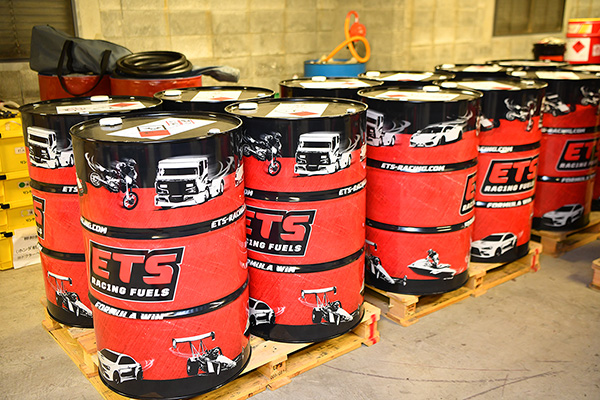
| 4/13-14 | Round1 OKAYAMA | |
| 5/03-04 | Round2 FUJI | |
| 6/01-02 | Round3 SUZUKA | |
| 8/03-04 | Round4 FUJI | |
| 9/21-22 | Round6 SUGO | |
| 10/19-20 | Round7 AUTOPOLIS | |
| 11/02-03 | Round8 MOTEGI | |
| 12/07-08 | Round5 SUZUKA |